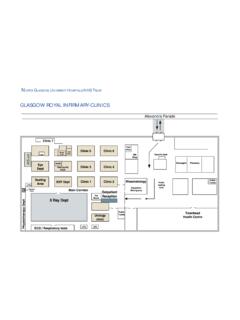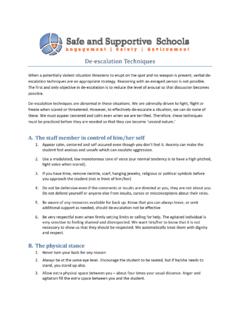Transcription of BEHAVIORAL STUDY OF OBEDIENCE - NHSGGC
1 Journal of Abnormal and Social Psychology1963, Vol. 67, No. 4, 371-378 BEHAVIORAL STUDY OF OBEDIENCE1 STANLEY MILGRAM 2 Yale UniversityThis article describes a procedure for the STUDY of destructive OBEDIENCE inthe laboratory. It consists of ordering a naive S to administer increasinglymore severe punishment to a victim in the context of a learning is administered by means of a shock generator with 30 gradedswitches ranging from Slight Shock to Danger: Severe Shock. The victim is aconfederate of the E. The primary dependent variable is the maximum shockthe S is willing to administer before he refuses to continue further. 26 Ssobeyed the experimental commands fully, and administered the highest shockon the generator.
2 14 Ss broke off the experiment at some point after thevictim protested and refused to provide further answers. The procedure createdextreme levels of nervous tension in some Ss. Profuse sweating, trembling, andstuttering were typical expressions of this emotional disturbance. One un-expected sign of tension yet to be explained was the regular occurrence ofnervous laughter, which in some Ss developed into uncontrollable variety of interesting BEHAVIORAL dynamics observed in the experiment,the reality of the situation for the S, and the possibility of parametric varia-tion within the framework of the procedure, point to the fruitfulness offurther is as basic an element in thestructure of social life as one can point system of authority is a requirementof all communal living, and it is only theman dwelling in isolation who is not forcedto respond, through defiance or submission.
3 To the commands of others. OBEDIENCE , asa determinant of behavior, is of particularrelevance to our time. It has been reliablyestablished that from 1933-45 millions ofinnocent persons were systematically slaugh-tered on command. Gas chambers were built,death camps were guarded, daily quotas ofcorpses were produced with the same ef-ficiency as the manufacture of inhumane policies may have originatedin the mind of a single person, but they couldonly be carried out on a massive scale if avery large number of persons obeyed is the psychological mechanismthat links individual action to political pur-pose. It is the dispositional cement that bindsmen to systems of authority.
4 Facts of recenthistory and observation in daily life suggest1 This research was supported by a grant (NSFG-17916) from the National Science studies conducted in 1960 were sup-ported by a grant from the Higgins Fund at YaleUniversity. The research assistance of Alan C. Elmsand Jon Wayland is gratefully Now at Harvard for many persons OBEDIENCE may be adeeply ingrained behavior tendency, indeed,a prepotent impulse overriding training inethics, sympathy, and moral conduct. C. (1961) points to its importance whenhe writes:When you think of the long and gloomy historyof man, you will find more hideous crimes havebeen committed in the name of OBEDIENCE thanhave ever been committed in the name of you doubt that, read William Shirer's "Rise andFall of the Third Reich.
5 " The German Officer Corpswere brought up in the most rigorous code ofobedience .. in the name of OBEDIENCE they wereparty to, and assisted in, the most wicked largescale actions in the history of the world [p. 24].While the particular form of obediencedealt with in the present STUDY has its ante-cedents in these episodes, it must not bethought all OBEDIENCE entails acts of aggres-sion against others. OBEDIENCE serves numer-ous productive functions. Indeed, the verylife of society is predicated on its may be ennobling and educativeand refer to acts of charity and kindness,as well as to ProcedureA procedure was devised which seemsuseful as a tool for studying OBEDIENCE (Milgram, 1961).
6 It consists of ordering371372 STANLEY MILGRAMa naive subject to administer electric shockto a victim. A simulated shock generator isused, with 30 clearly marked voltage levelsthat range from IS to 450 volts. The instru-ment bears verbal designations that rangefrom Slight Shock to Danger: Severe responses of the victim, who is a trainedconfederate of the experimenter, are stand-ardized. The orders to administer shocks aregiven to the naive subject in the context ofa "learning experiment" ostensibly set up tostudy the effects of punishment on the experiment proceeds the naive subjectis commanded to administer increasinglymore intense shocks to the victim, even tothe point of reaching the level markedDanger: Severe Shock.
7 Internal resistancesbecome stronger, and at a certain point thesubject refuses to go on with the experi-ment. Behavior prior to this rupture is con-sidered " OBEDIENCE ," in that the subject com-plies with the commands of the point of rupture is the act of disobedi-ence. A quantitative value is assigned to thesubject's performance based on the maximumintensity shock he is willing to administerbefore he refuses to participate further. Thusfor any particular subject and for any par-ticular experimental condition the degree ofobedience may be specified with a numericalvalue. The crux of the STUDY is to systemati-cally vary the factors believed to alterthe degree of OBEDIENCE to the technique allows important variablesto be manipulated at several points in theexperiment.
8 One may vary aspects of thesource of command, content and form of com-mand, instrumentalities for its execution,target object, general social setting, etc. Theproblem, therefore, is not one of designing in-creasingly more numerous experimental con-ditions, but of selecting those that best illumi-nate the process of OBEDIENCE from the socio-psychological StudiesThe inquiry bears an important relation tophilosophic analyses of OBEDIENCE and author-ity (Arendt, 1958; Friedrich, 1958; Weber,1947), an early experimental STUDY ofobedience by Frank (1944), studies in "au-thoritarianism" (Adorno, Frenkel-Brunswik,Levinson, & Sanford, 1950; Rokeach, 1961),and a recent series of analytic and empiricalstudies in social power (Cartwright, 1959).
9 It owes much to the long concern withsuggestion in social psychology, both in itsnormal forms ( , Binet, 1900) and in itsclinical manifestations (Charcot, 1881). Butit derives, in the first instance, from directobservation of a social fact; the individualwho is commanded by a legitimate authorityordinarily obeys. OBEDIENCE comes easily andoften. It is a ubiquitous and indispensablefeature of social subjects were 40 males between the ages of20 and 50, drawn from New Haven and the sur-rounding communities. Subjects were obtained bya newspaper advertisement and direct mail solicita-tion. Those who responded to the appeal believedthey were to participate in a STUDY of memory andlearning at Yale University.
10 A wide range ofoccupations is represented in the sample. Typicalsubjects were postal clerks, high school teachers,salesmen, engineers, and laborers. Subjects ranged ineducational level from one who had not finishedelementary school, to those who had doctorate andother professional degrees. They were paid $ fortheir participation in the experiment. However, sub-jects were told that payment was simply for comingto the laboratory, and that the money was theirsno matter what happened after they arrived. Table 1shows the proportion of age and occupational typesassigned to the experimental and LocaleThe experiment was conducted on the grounds ofYale University in the elegant interaction laboratory.

















